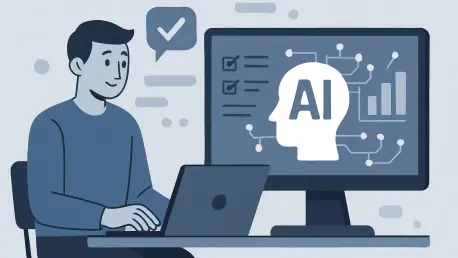As artificial intelligence continues to reshape industries with unprecedented speed, organizations face a pressing challenge: how to integrate this powerful technology without risking significant resources on unproven solutions. The allure of AI, with its promise to streamline operations, enhance decision-making, and drive innovation, often overshadows the practical hurdles of adoption. Yet, without a structured approach to evaluate its fit and effectiveness, businesses risk costly missteps. A strategic focus on testing AI in controlled, real-world scenarios can bridge the gap between hype and tangible value. This careful process ensures that investments align with specific needs and deliver measurable outcomes. By prioritizing intentional implementation over blind enthusiasm, companies can transform AI from a speculative gamble into a reliable tool for growth and efficiency. The path forward lies in deliberate experimentation, grounded in clear objectives and practical assessments, to unlock AI’s potential while minimizing exposure to pitfalls.
Defining Clear Objectives for AI Integration
The foundation of any successful AI adoption lies in a precise understanding of what an organization hopes to achieve with the technology. Before diving into implementation, businesses must thoroughly analyze their operations to identify specific pain points or inefficiencies that AI could address. These might range from optimizing supply chain logistics to enhancing customer service through predictive analytics. Without this clarity, there’s a significant risk of investing in solutions that fail to deliver meaningful impact. A targeted approach ensures that every step of the AI journey aligns with overarching goals, whether it’s reducing operational costs or improving decision-making accuracy. This initial phase of defining objectives acts as a compass, guiding organizations away from trendy but irrelevant applications and toward solutions that address real challenges. By grounding decisions in concrete needs, companies can avoid the common trap of chasing innovation for its own sake, paving the way for more effective testing and deployment strategies.
Once objectives are set, the next critical task is to map out how AI can realistically solve the identified issues within the organization’s unique context. This involves a deep dive into existing processes to pinpoint where technology can add value, such as automating repetitive tasks or providing insights from vast datasets. It’s equally important to consider scalability and long-term benefits, ensuring that chosen solutions don’t just offer quick fixes but contribute to sustained growth. Engaging cross-functional teams in this planning phase can provide diverse perspectives, helping to uncover blind spots and refine goals. For instance, input from frontline staff might reveal practical constraints that executives overlook. This collaborative effort not only sharpens the focus on relevant use cases but also builds internal consensus, which is vital for smooth implementation. By establishing a clear roadmap tied to specific outcomes, organizations create a solid benchmark against which to measure the success of AI trials, setting the stage for informed decision-making.
Testing AI in Real-World Scenarios
With objectives in place, the focus shifts to evaluating AI solutions through practical, real-world testing to confirm their effectiveness before full-scale commitment. This phase is akin to taking a vehicle for a test drive—while a high-performance model might dazzle on paper, only hands-on experience reveals if it suits day-to-day needs. Similarly, AI tools must be assessed in environments that mirror actual operational conditions to gauge their true utility. Proofs of concept and pilot programs offer a low-risk way to observe how a system performs against specific challenges, whether it’s predicting inventory shortages or detecting fraudulent transactions. These controlled trials provide critical data on functionality, revealing gaps between promised capabilities and actual results. Such insights are invaluable for avoiding large-scale failures, allowing businesses to refine or pivot strategies based on evidence rather than assumptions, thus safeguarding resources.
Beyond initial trials, incorporating feedback loops during testing ensures that AI solutions evolve to meet organizational demands more effectively. Gathering input from end users and stakeholders during pilot phases helps identify unforeseen issues, such as integration challenges with existing systems or usability concerns. This iterative process allows for adjustments in real time, fine-tuning the technology to better align with practical workflows. Additionally, measuring key performance indicators during these tests—such as time saved or error rates reduced—offers quantifiable evidence of value. A logistics firm, for example, might test an AI-driven routing tool to see if delivery times improve under varying conditions. If results fall short, the trial provides a safe space to explore alternatives without disrupting core operations. This methodical approach to validation builds confidence in the technology’s potential, ensuring that when full deployment happens, it’s backed by proven performance rather than speculative promise.
Prioritizing Customer Value in AI Development
For organizations developing AI as part of their products or services, the emphasis must rest on delivering genuine value to customers rather than showcasing technical prowess. Sophisticated algorithms or lightning-fast models mean little if they don’t address real user needs or enhance experiences in meaningful ways. The development process should start with a deep understanding of customer pain points, ensuring that every feature or capability directly tackles those issues. Whether it’s a healthcare app using AI for faster diagnostics or a financial tool detecting fraud, the end goal remains the same: tangible improvement for the user. This customer-centric mindset keeps innovation grounded, preventing resources from being squandered on features that dazzle but fail to solve core problems. By aligning development with user expectations, companies can build trust and loyalty, turning AI into a competitive advantage that resonates in the marketplace.
Equally critical in this process is the ongoing evaluation of how AI-driven products perform in customers’ hands, using real-world feedback to drive continuous improvement. Post-launch testing through user surveys, usage analytics, and direct input can reveal how well the technology meets expectations and where it falls short. For instance, a retail platform leveraging AI for personalized recommendations might discover through customer data that suggestions miss the mark due to incomplete user profiles. Addressing such gaps ensures the solution remains relevant over time. This commitment to refining based on actual usage patterns not only enhances product quality but also demonstrates responsiveness to customer needs. By embedding this focus on value into every stage of development and testing, organizations position their AI offerings as indispensable tools rather than mere novelties, fostering long-term success in an increasingly competitive landscape.
Building a Balanced Approach to AI Adoption
Looking back, the journey of integrating AI into organizational frameworks demanded a blend of caution and curiosity, as companies navigated both its transformative potential and inherent risks. Many found success by grounding their efforts in well-defined goals, ensuring that every investment tied back to specific operational challenges. Real-world testing emerged as a cornerstone, with pilot programs and iterative feedback loops helping to validate solutions before broader rollout. For developers, a relentless focus on customer value shaped innovations that truly mattered to end users. Moving forward, the lesson remains clear: a balanced approach rooted in pragmatism can turn AI into a powerful driver of efficiency and growth. Organizations should continue to prioritize strategic testing, refine objectives as technologies evolve, and remain agile in addressing emerging challenges. By maintaining this disciplined yet open-minded stance, businesses can confidently harness AI’s capabilities, transforming potential into lasting impact.









